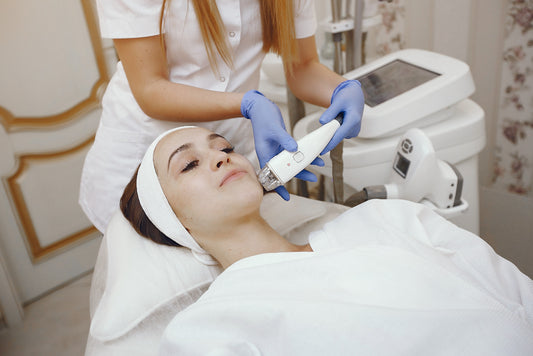Whether you're considering getting a chemical peel or are about to have your first peel and wondering about the aftercare involved, this blog post is for you.
Chemical peel aftercare is an integral part of the process. Chemical peels are among the most common cosmetic dermatology treatments in the U.S., used to enhance skin texture and complexion.
Many of us already know that a chemical peel is a process in which a solution containing chemicals is applied to the skin, which exfoliates it and eventually leads to peeling. This typically results in smoother skin with improved tone and color.
Proper aftercare is crucial to prevent breakouts, infections, and scarring. Before we delve into this guide on chemical peel aftercare, let's learn more about what to expect during a chemical peel treatment.
Although chemical peel is generally considered safe, only some are ideal candidates for a chemical peel. Your skin care professional can help you determine if a chemical peel is the appropriate cosmetic treatment for you.
What to Expect After A Chemical Peel
So, what to expect or do after a chemical peel?
Regardless of the chemical peel variety you opt for, there are specific guidelines for chemical peel aftercare to adhere to, along with an anticipated period of recovery.
Chemical peels can lead to immediate redness and swelling of the skin post-peel. Swelling might peak within the initial 48 hours following the chemical peel.
Interestingly, some individuals might not experience visible peeling; in such cases, results are still noticeable as the skin has undergone microscopic peeling.
Proper Skin Care After A Chemical peel

There are some primary aspects to remember for your chemical peel aftercare. Practice the following essentials to minimize your skin's downtime after an at-home or clinical chemical peel.
-
Use Cold Water to Wash Your Face
Cool or cold water, which can relieve post-peel sensations, might be more pleasant than warm or hot water.
-
Hydrate & Moisturize
Moisturize and hydrate your skin well after undergoing chemical peels. Due to the temporary compromise of your skin's protective barrier by peels, it's essential to strengthen this barrier with a medium-to-thick moisturizer.
Additionally, increasing your water intake can help prevent dehydration, which may contribute to skin tightness.
- Apply Sunscreen with SPF30 Minimum
The skin becomes more delicate after the peeling process. We advise you to avoid direct sun exposure, which can worsen the situation and amplify the signs of aging on your skin. If you really have to face the sun anyway, use sunscreen protection.
- Refrain from intense Workouts, Using Dry Saunas, and visiting Stream Rooms
On the day you use a peel, avoiding activities that boost blood circulation to the face is best. These activities can exacerbate sensations of warmth, tingling, itching, redness, or other uncomfortable side effects on freshly peeled skin.
- Don't Over-Exfoliate
Since peels are potent exfoliants, there's no requirement to incorporate an additional exfoliating product (such as a scrub, brush, or exfoliating cleanser) into your skincare routine for 3-4 days following your peel.
Excessive exfoliation can result in increased redness or sensitivity, so it's advisable to wait until your skin feels ready before resuming such practices.
- Moisturize Often
Allowing the skin to become dry could lead to discomfort. In the case of potent peels, you can apply aloe vera for the initial few days or whenever necessary, especially on sensitive peeling areas.
As peeling begins, employ a non-comedogenic moisturizer until the skin regains its usual condition. This practice will aid the healing process by sealing in moisture and minimizing the risk of bacterial infections, redness, and irritation.
Apply this regimen multiple times a day or as required.
- Consult with Your Skin Therapist
After your skin has returned to its usual state following a peel, it's generally acceptable to resume your regular skincare routine. For customized guidance, consult your professional skin therapist on how best to integrate peels into your lifestyle.
Ensuring the protection of your skin post-treatment is crucial, given its heightened sensitivity during the chemical peel recovery period.
This entails sidestepping excessive heat and sun exposure. Restrict intense workouts, apply sunscreen, and wear protective attire to achieve this.
Accelerating the Peeling Process

After a Chemical Peel Regrettably, there's no proven method to hasten the peeling process after a chemical peel, and some individuals might not experience peeling at all. Nonetheless, maintaining adequate skin hydration can aid in promoting overall healing.
Whether you’re considering a chemical peel or microneedling to enhance your skin, Our offices are at your service for those seeking more information about chemical peels post-peel care or to schedule an appointment.
Why Is Chemical Peel Aftercare So Essential?

Correct chemical peel aftercare is vital for the safe and effective healing of the treated skin. Proper aftercare following a chemical peel is crucial to ensuring the skin heals safely and free from complications.
It also alleviates the discomfort associated with the recovery process, reducing the inclination to excessively touch the treated area.
As the outer skin layer sheds, the skin becomes highly susceptible to sunlight, necessitating protection against sun damage, including burns.
The skin's ability to retain moisture diminishes with its protective barrier and natural oils removed. Hydration must be supplemented through the application of a suitable moisturizer.
Sticking diligently to the chemical peel aftercare regimen is imperative; any deviation could lead to temporary or lasting skin damage, potentially compromising the anticipated treatment outcomes.
Click here to book a chemical peel with Us!
Is Moisturizing Necessary Following A Chemical Peel?

Absolutely! Here's what to put on your face after a chemical peel. A soothing, gentle moisturizer!
Moisturizing is essential after undergoing a chemical peel. Allowing your skin to dry excessively can lead to discomfort, which is particularly relevant as dryness is a common post-chemical peel experience.
Consider applying Vaseline to the treated area in the initial days for medium or deep peels. As the peeling phase begins, opt for a non-comedogenic moisturizer until your skin is healing.
Maintaining well-moisturized skin during recovery fosters healing by retaining hydration and minimizing irritation, redness, and the risk of bacterial infections.
How to Cleanse or Wash Your Face After A Chemical Peel
When cleansing your face after a chemical peel, the foremost rule is to approach it gently. Your skin will be exceptionally delicate in the week following your treatment.
Use only cool water and mild cleansers for face washing throughout the healing phase. This involves using your fingertips exclusively and avoiding washcloths, sponges, or other cleansing implements.
Chemical Peel At The Med Spa At
The Med Spa At delivers medical, surgical, and cosmetic dermatology through a team of exceptionally trained physicians and clinicians in Rio Rancho and Scottsdale.
Reach out to our team at or explore our contact page to discover our locations.
You can also stay updated on dermatology developments by following us on Facebook.
Related Topics:
Can You Use Botox Under Eyes? Read Before Using!
How Long Does Body Contouring Last? [Answered] - The Med SPA
Clear + Brilliant Vs. IPL: Which Treatment is Right for You?
How Long Does Laser Hair Removal Take? {Answered} - TheMedSpa



 Skin Treatments
Skin Treatments





